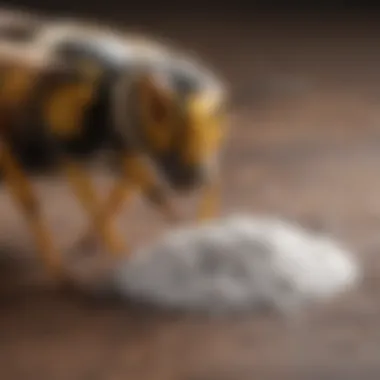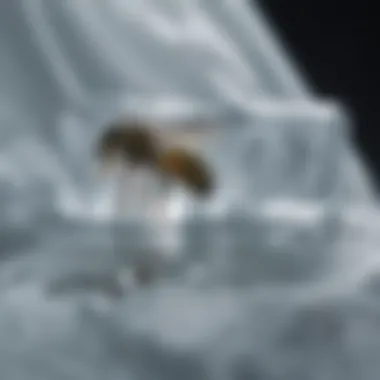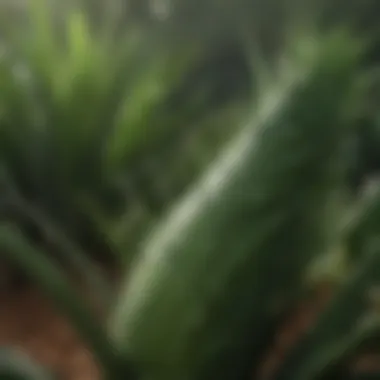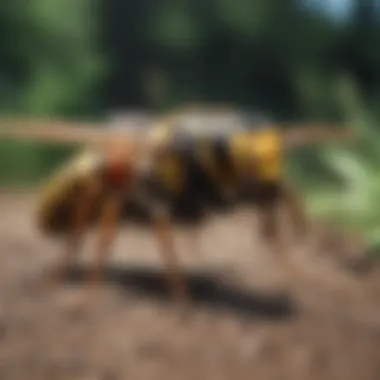Home Remedies to Alleviate Wasp Sting Pain and Swelling


Intro
Wasp stings evoke a multitude of reactions that range from mild discomfort to an overwhelming fear of encountering these buzzing insects again. Understanding the biological mechanics behind wasp stings can make all the difference when it comes to addressing their aftermath effectively. Knowing how to respond to this unexpected incident is essential, especially for those who enjoy outdoor activities or reside in areas with high wasp populations.
Addressing the pain, swelling, and general distress caused by a sting can be tackled with methods that are not only practical but readily available in most households. As we delve deeper into effective home remedies, we’ll also highlight the importance of recognizing when the situation demands medical attention. Furthermore, preventive measures will be discussed to help avoid these painful encounters in the future.
Understanding Wasp Stings
Understanding wasp stings is crucial when addressing pain and discomfort following such an incident. Knowing the types of wasps, their behavior, and how their stings work can help individuals deal with stings more effectively. With the right knowledge at hand, one can distinguish between a typical sting reaction and signs of a more serious allergic response. This awareness is an essential first step in ensuring not only swift treatment but also informed decisions about seeking medical help when necessary.
Types of Wasps
In the vast world of wasps, a few distinct types take center stage. The most common stinging culprits include:
- Yellow Jackets: Known for their black and yellow coloration, yellow jackets are often found scavenging around picnics and outdoor gatherings. They can be quite aggressive, particularly when defending their nests.
- Paper Wasps: These wasps boast slender bodies and long legs. They tend to build open nests that resemble an umbrella and are generally less aggressive than yellow jackets. However, they will sting if they feel threatened.
- Bald-Faced Hornets: Surprisingly, these hornets are a type of wasp. They are known for their black and white coloration and aggressively defend their nests. Their sting is extremely painful and can lead to serious reactions in sensitive individuals.
Being aware of these types not only helps in understanding the potential severity of a sting but also aids in anticipating their behavior.
How Wasp Stings Work
When a wasp stings, it injects venom through its stinger. Unlike bees, which leave their stinger behind, wasps can sting multiple times. The venom contains various proteins that affect skin cells and the immune system, leading to pain, swelling, and irritation.
A common misconception is that all stings from wasps lead to severe reactions. In reality, for many people, a wasp sting results in localized pain, redness, and swelling. However, for those with allergies, even a single sting can trigger a life-threatening reaction known as anaphylaxis. Thus, understanding how these stings work helps individuals prepare and respond appropriately.
Symptoms of a Wasp Sting
Recognition of symptoms following a wasp sting is vital. Typical symptoms include:
- Immediate pain: Often sharp and stinging in nature, it can last for several hours.
- Redness and swelling: The affected area may become red, swollen, and tender.
- Itching: As the sting site heals, itching may occur, often prompting people to scratch, which can worsen the irritation.
- Allergic reactions: These may manifest as hives, difficulty breathing, or swelling in the throat. If any of these symptoms emerge, immediate medical attention is essential.
"Recognizing the symptoms early can be the difference between a minor inconvenience and a major health crisis."
In summary, knowing how to identify the symptoms and understanding the dynamics of wasp stings empowers individuals to react wisely during such incidents. Beyond that, a profound understanding can facilitate more informed choices about home remedies and when to seek professional care.
Initial Steps to Take After Being Stung
Experiencing a wasp sting can be a startling event. The moment you realize you’ve been stung, it can send your heart racing. Understanding the initial steps to take after being stung is critically important. These first actions can greatly influence the pain and swelling that may follow. Taking the right steps soon after the incident can help in reducing discomfort and promoting healing.
Removing the Stinger
The very first thing to do is check if the stinger is still lodged in your skin. Wasps typically do not leave their stingers in you like bees do. But if you spot a stinger, it's crucial to get rid of it promptly. Use a pair of tweezers to gently grasp it. You don’t want to pinch the venom sac, as squeezing it could inject more venom into your skin.
Tip: Pay attention to the area around the sting.


If it’s around sensitive areas such as your face or neck, exercise caution while removing the stinger. In some cases, it could swell significantly, complicating the removal. Always be gentle and avoid using your fingers directly, as it increases the risk of pushing venom deeper.
Cleaning the Affected Area
Once you’ve handled the stinger, the next critical step is to clean the area thoroughly. This reduces the risk of infection. Use soap and water to cleanse the site gently. Avoid scrubbing hard, as it might worsen inflammation. A mild antiseptic can be beneficial too. A light pat with a clean towel would suffice to dry off the area.
When cleaning, try to keep the area clear from anything that could irritate it further—avoid any strong soaps or fragrances that could cause additional irritation.
Applying Cold Compresses
After cleaning, it’s a good idea to apply a cold compress. This can significantly relieve pain and reduce swelling. Simply grab an ice pack or a bag of frozen vegetables and wrap it in a clean cloth.
Apply the compress for about 10 to 15 minutes. If it feels too cold against your skin, don't hesitate to remove it sooner. The cold will constrict blood vessels, minimizing swelling and numbing the pain. Be cautious and never apply ice directly on the skin.
Following these initial steps effectively sets the stage for further home remedies. It’s pertinent to stay observant over the next few hours for any unusual reactions, as they might signal the need for medical assistance.
Home Remedies for Pain Relief
When a wasp stings, the immediate aftermath often brings with it a wave of unsettling pain and anxiety. Knowing how to ease this pain is crucial, especially when you find yourself away from medical resources. Home remedies provide not only relief but also peace of mind. They are often accessible, cost-effective, and can be applied immediately. By having a few handy treatments in your arsenal, you stand a better chance of managing discomfort effectively.
Baking Soda Paste
Baking soda is a remarkable ingredient that acts as a natural remedy due to its alkaline nature. When mixed with water to create a paste, it helps neutralize the acidity from the wasp's venom. To prepare a baking soda paste, simply combine a few teaspoons of baking soda with just enough water to make a thick mixture.
Apply this paste directly to the sting site. The coolness of the paste coupled with its soothing properties can significantly alleviate the immediate burning sensation. Leave it on for about 15 to 20 minutes to let it work its magic. Many folks swear by this simple remedy, often citing relief within minutes.
"Baking soda has been a household staple for generations, serving as both a leavening agent in baking and a reliable treatment for minor stings."
Apple Cider Vinegar Application
Another effective home remedy is apple cider vinegar. This age-old elixir, known for its various health benefits, can also assist in mitigating the symptoms of a wasp sting. Its acidic nature helps neutralize the venom, reducing pain and potential inflammation.
To utilize this remedy, soak a cotton ball in apple cider vinegar and apply it directly to the sting area. You can leave the cotton ball on the sting for approximately 30 minutes. Many people find that this remedy not only eases pain but also helps to reduce swelling and redness in the affected area. Furthermore, the aroma of apple cider vinegar can sometimes function as a deterrent to additional stings.
Essential Oils and Their Benefits
Essential oils are another pathway to pain relief. Oils like lavender and tea tree have anti-inflammatory and calming properties that can work wonders when applied to a wasp sting. Lavender oil, for instance, is renowned for its soothing qualities. A drop or two, gently massaged into the sting site, can help ease discomfort significantly.
Tea tree oil, on the other hand, has antibacterial properties, which can be beneficial in preventing infection at the sting site. Always remember to dilute essential oils with a carrier oil before application, as they can be quite potent. A simple recipe is mixing a couple of drops of essential oil with a tablespoon of coconut or olive oil. This not only makes the application pleasant but also safe for the skin.
In summary, home remedies such as baking soda paste, apple cider vinegar, and essential oils can offer significant relief from the discomfort caused by wasp stings. They are easy to implement and can bring comfort when you need it most, allowing you to focus more on feeling better and less on the sting.
Managing Swelling and Inflammation
Managing swelling and inflammation is a pivotal aspect of recovering from a wasp sting. Understanding these symptoms can help individuals determine the best course of action to alleviate discomfort and foster quicker healing. Swelling often occurs when the body responds to the venom injected during a sting. This immune reaction is somewhat like a defense mechanism, as it attempts to isolate the venom and prevent it from spreading too far into the bloodstream. However, while this response is vital, the accompanying pain and inflammation can be extremely bothersome.


By focusing on reducing swelling, you not only enhance comfort but also minimize potential complications, such as delayed healing or the risk of infection. It's important to approach this with a holistic view that incorporates several remedies and strategies designed to address these symptoms effectively.
Over-the-Counter Antihistamines
Over-the-counter antihistamines are commonly recommended to control the itchy feelings and swelling that can come from a nasty wasp sting. These medications work by blocking histamine, a chemical that your body releases during an allergic reaction. Popular options include diphenhydramine, otherwise known as Benadryl, and cetirizine, known as Zyrtec.
When considering antihistamines, it’s wise to follow the dosage instructions closely and to be aware of possible side effects, such as drowsiness or dry mouth. For those needing relief during the day, choosing non-drowsy options is critical. Always consult with a healthcare provider if there's any uncertainty regarding the suitability of these medications for your specific condition or if you've experienced severe reactions in the past.
Cold Water Soaks
Cold water soaks are another effective home remedy for controlling swelling and inflammation after a wasp sting. Submerging the affected area in cool water can provide immediate relief. The cold acts as a natural anesthetic, reducing blood flow and lessening the swelling, similar to how a bag of ice would work.
To prepare a soak, fill a basin with cold water or use ice packs wrapped in cloth directly on the sting area. Immerse the affected body part for about 10 to 15 minutes. It’s advisable to repeat this process several times a day as needed. This simple method not only eases swelling but also soothes pain effectively, giving your body the chance to heal without unnecessary discomfort.
Herbal Remedies to Reduce Inflammation
Several herbal remedies have been noted for their anti-inflammatory properties and can help manage the swelling caused by a wasp sting. Among them are witch hazel, calendula, and chamomile, which are known for their soothing effects.
- Witch Hazel: Often applied topically, witch hazel can reduce inflammation. It can be dabbed onto the sting site with a cotton ball.
- Calendula: This herb is recognized for its skin-healing properties. A salve made from calendula can provide relief from swelling and could support overall skin health after a sting.
- Chamomile: This popular tea also contains anti-inflammatory properties. Brewed tea bags can be cooled and placed on the sting site for added comfort.
Using herbal remedies requires some caution. Ensure you are not allergic to these plants. Additionally, they should support other treatments, rather than replace conventional medical advice when symptoms escalate. Always keep a keen eye on the body’s reactions.
"The key to effective treatment highlights the balance between the body’s own healing powers and guided interventions; utilizing natural remedies can boost this process."
In sum, managing swelling and inflammation effectively is essential for a smoother recovery from a wasp sting. By judiciously using over-the-counter antihistamines, cold water soaks, and herbal remedies, you can create a much more comfortable experience following this distressing encounter. Be observant and discerning in your approach; your body will thank you.
When to Seek Medical Help
When dealing with a wasp sting, knowing when to seek medical attention can make all the difference. Many people can manage the discomfort at home; however, some situations are best suited for professional evaluation. Identifying warning signs early can be crucial, especially if allergic reactions are a factor.
Identifying Allergic Reactions
Allergic reactions to wasp stings can vary dramatically, encompassing everything from mild irritation to severe, life-threatening conditions. It’s essential to recognize these signs promptly. Common indicators of an allergic response include:
- Hives or rash around the sting site or elsewhere on the body.
- Swelling of the face, lips, or throat.
- Difficulty breathing or wheezing.
These symptoms suggest that the body is reacting against the venom in an exaggerated way. In such cases, it’s advisable to seek medical assistance immediately. Remember, even if a person has been stung before without issues, they can develop new allergies at any time.
Symptoms Requiring Urgent Care
Several symptoms should prompt a swift trip to the emergency room. These include:
- Shortness of breath: If a person is struggling to breathe or feels tightness in the chest, it's critical to get help fast.
- Rapid heartbeat: An unusual or fast heartbeat can signify a severe allergic reaction.
- Dizziness or fainting: This might indicate shock or a drop in blood pressure, which is common during an allergic response.
- Severe swelling: If the sting leads to significant swelling beyond the sting site, it can also be a serious sign.


In any case of uncertainty, it's better to err on the side of caution. Seek help as soon as you suspect a severe reaction.
Keeping an eye on key symptoms and reacting quickly can save lives. After a wasp sting, the body’s diverse responses can be unpredictable, particularly for those predisposed to allergies. Therefore, vigilance in monitoring your condition can greatly affect the outcome.
Preventative Measures for Future Encounters
Considering the discomfort and potential complications that result from a wasp sting, taking preventative measures becomes crucial. By making informed choices and adopting certain behaviors, we can significantly reduce the chances of encountering these buzzing nuisances. Each of the following sections outlines practical tips designed to keep you safe from unexpected wasp encounters, focusing on awareness and proactive steps.
Avoiding Areas with Nesting Wasps
To steer clear of potential stinging incidents, it is vital to recognize environments where wasps typically build their nests. These areas often include eaves, attics, and underground burrows. Understanding the signs of a wasp nest can be quite beneficial. Look for wasps flying in and out of small openings or gathering around certain structures.
- Stay Alert: If you notice a significant number of wasps in a specific area, it's best to give that zone a wide berth.
- Schedule Outdoor Activities Wisely: Wasps are drawn to food and sugary drinks, particularly during warm months. Plan outdoor activities during times when wasps are less likely to be active, like early morning or late evening.
Being cautious about your surroundings can be the difference between an enjoyable day outside and an unexpected sting.
Clothing and Scent Considerations
What you wear can play a significant role in attracting or repelling wasps. Bright colors and floral patterns may catch their eyes, while dark colors are less tempting. Therefore, consider donning neutral-colored clothing when spending time outdoors.
Additionally, fragrances can pique a wasp's interest. Here are some tips to help minimize your appeal to these insects:
- Avoid Strong Scents: Steer clear of heavily scented soaps, lotions, and perfumes, as these can attract wasps.
- Dress Smartly: Opt for long sleeves and closed-toed shoes to protect your skin in case of an unexpected encounter.
Using Natural Repellents
Natural repellents serve as an effective line of defense against wasps without resorting to harsh chemicals. Utilizing easily accessible ingredients can offer an additional layer of protection. Here’s a list of some natural repellent options:
- Peppermint Oil: Wasps detest the strong smell of peppermint; mix a few drops in water and spray it around areas where you frequent.
- Vinegar: A solution of vinegar and water can also disrupt their attraction, providing a relatively simple deterrent.
- Cucumber Slices: Surprisingly, wasps are not fond of cucumbers. Placing slices in exposed areas might be a helpful tip.
By implementing these natural methods, you can create a less inviting atmosphere for wasps, enabling you to enjoy your time outdoors while minimizing the risk of stings.
"Prevention is better than cure." Integrating these preventative measures not only safeguards your well-being but also enhances your overall experience in nature.
End
Summary of Effective Treatments
Using home remedies can significantly mitigate the unpleasant symptoms of a wasp sting. Commonly employed treatments include:
- Baking Soda Paste: Created by mixing baking soda with water, this paste can help neutralize the acidity of the venom.
- Apple Cider Vinegar Application: The acidity of vinegar can also play a role in reducing pain and swelling.
- Essential Oils: Oils such as lavender or tea tree are lauded for their soothing properties and can serve as topical remedies.
You can choose from a variety of methods to relieve pain and manage symptoms. Understanding what works best for you or your family can make a world of difference in those moments of distress.
Final Thoughts on Caution and Care
Even though the home remedies discussed show promising results, it is crucial to remember the importance of caution. Always monitor for any signs of an allergic reaction, as immediate medical intervention might be necessary in those situations. While it’s tempting to treat the sting without medical guidance, recognizing personal health limitations is vital. Moreover, it is wise to keep a well-stocked first aid kit at home, including antihistamines and topical remedies, to be prepared for such stings that may arise unexpectedly.
Being proactive in safeguarding against future stings also contributes to peace of mind; understanding safe practices, such as avoiding heavily perfumed products or tightly enclosed spaces where wasps are active, can reduce the risk.
Overall, being informed and prepared can alleviate fear and anxiety surrounding encounters with wasps, enabling better handling of these pesky sting incidents.







